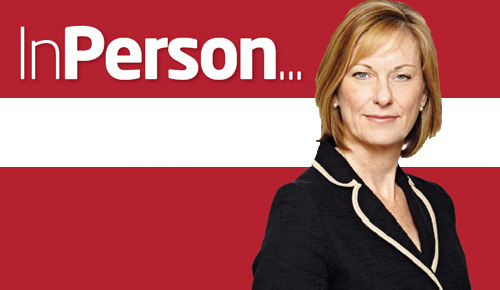Presentation skills can complement your clinical ones, says CSP chief executive Karen Middleton.

September and October are particularly busy months for conferences. I seem to attend at least two a week to speak, listen, or ask questions and, of course, to promote physiotherapy to others.
Public speaking is a key skill. We’ve all sat through presentations that have been inspiring – and ones where we’ve quickly become bored.
But presenting is a skill we, as clinicians and leaders, need to develop. The opportunity often starts at an undergraduate level as we learn to present to other students. As clinicians we then move on to presenting case studies to clinical colleagues. We may then move to larger groups and finally to a conference audience.
However, whatever the level, the process you go through in preparing for and delivering a presentation is pretty much the same. I will share with you some of my top tips but must stress this is a skill that needs formal training to develop. The best training I had was from actors at the Old Vic, although the training itself was agony. You need to practise and to garner honest feedback.
Preparation is everything. What is the conference about? Who is the audience? Who else is speaking? What sort of venue will it be and what technical support is available? The technology support people are your best friends, so work with them.
And, of course, what are you going to talk about and for how long? Balance what you think, or know, the audience want to hear about and what you want to convey.
Once you have your subject matter, think about the ‘story’ you want to tell. It needs to have a beginning, middle and an end. What is the narrative?
At this point I start jotting down broad points I want to make and then gradually fill it out with content. I tend to type out the full speech, then break it down into prompt cards and then, perhaps on the day, not even use them. It just depends on the nature of the lecture or presentation. Reading verbatim notes is fine in certain circumstances but not in others.
If you use PowerPoint slides be careful that they add to what you are saying and don’t distract the audience. Ensure they are readable from a distance. It is crucial that you say more than what is on the slides – or else why not just send your presentation to members of the audience?
Then practise. If this is new to you, practise out loud as you need to hear yourself speak. And always check your timing, remembering that you may well speak quickly if you are feeling nervous.
On the day itself, try to go to the venue in advance and get the feel of the place and the technology you will be using.
And then there is you. We all get nervous in these circumstances, in fact this is necessary to ensure you have sufficient adrenaline to perform, but it is important to control those nerves. Remember that you know more than anyone in the room about the specific subject you are going to talk about and that the audience is there to listen to you.
Dress for the occasion as this shows you respect your audience. Ensure you have your opening line ready but be prepared to respond to anything said in the introduction.
And then off you go!
Do make eye contact with people in the audience, if you can. Do look up and out and try not to look back at your slides. Use pauses, change your rate and tone of speaking and repeat key points.
And one thing about humour - do use it appropriately but don’t force it.
The most important thing about presenting is to be yourself. Never bluff the answer to a question: be prepared to say you don’t know, but will find out.
Presenting is a performance and, once mastered, it will help in so many other areas of your professional life. fl
Author
Karen MiddletonNumber of subscribers: 1
